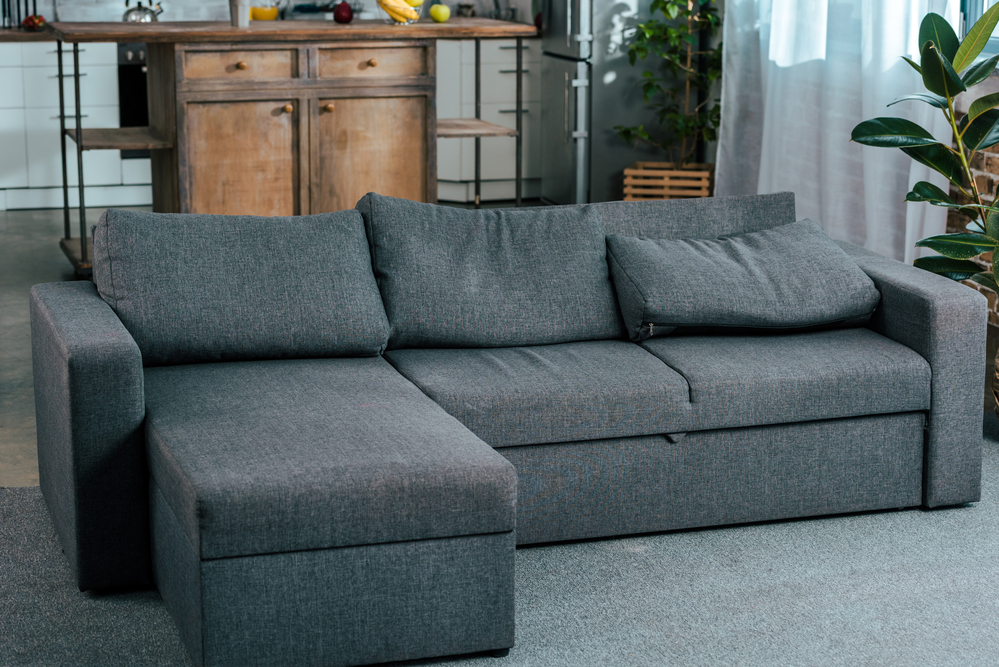Why are Couches so Expensive? (Plus Some Tips To Get a Great Deal)
Homebody Forever is reader-supported. We may receive a commission if you make a purchase through a link on this post.

Purchasing a couch can be quite an investment, but as us homebodies know, a comfy sofa is necessary to a happy life. After all, we spend a lot of our spare time there.
The primary reason couches are so expensive is the cost of materials. While high-quality materials tend to have better durability and comfort, they’re unsurprisingly more expensive.
Some other reasons include:
- Advanced features like reclining options—which often require a more complex manufacturing process— can raise the price.
- Transportation costs. Due to their bulky nature, couches cost more to transport, and this expense is, unfortunately not passed on to the consumer.
- Supply and demand. A couch isn’t something that you buy often and if you’re a furniture owners, you need to work with that reality. As a result, they need to put high margins on their products in order to stay profitable.
Read on to find learn more about why sofas are so expensive and how you can get a good deal if you’re in the market for a new one.
Related: The Reasons Dining Chairs are So Expensive

Factors That Influence Couch Prices
Material Costs
One significant factor that influence the consumer price of couches is the material used in their construction. Couches can be made from a variety of materials, such as:
- Wood: A common material for couch frames, the type and quality of the wood can lead to a wide variation in price. Hardwoods like oak or maple, for example, tend to be more expensive than softwoods like pine.
- Upholstery: Couches can be upholstered with various fabrics like leather, velvet, linen, or wool. These materials all have a different price-point. High-quality fabrics, like genuine leather or wool, often result in higher costs.
- Cushions and foam: The filling materials for cushions can range from standard polyurethane foam to memory foam, down feathers, or a combination of materials. The better the quality of the foam, the more expensive the couch is likely to be.
- Springs and support: Different couches use varying support systems like sinuous springs, hand-tied springs, or even webbing. Higher-quality springs can also make the final price more expensive.

Labor and Production Costs
Couches can be either factory-made or custom-made:
- Factory-made couches are often produced on a large scale and aim to balance quality, cost, and production efficiency. You’ll typically find that these will be cheaper than custom-made ones, though the price range can still vary.
- Custom-made couches or luxury brands often have higher labor costs due to the skilled craftsmanship and attention to detail required. Custom orders can also increase the couch’s price because of the time and effort involved in creating a unique piece.
Brand Reputation and Marketing
The brand behind a couch can also impact its price. Some companies have built strong reputations for high-quality products, leading to higher demand and increased costs. These brands may also invest in marketing and setting up showrooms, which can raise the overall price of their products.
Design and Customization Options
The design of a couch also plays a crucial role. Couches with more intricate designs, advanced features like recliner options, or unique upholstery elements tend to be more expensive.
Different Couch Materials and Their Costs
In this section, we’ll dive into the various couch materials and their costs. Understanding the different materials will help you make an informed decision on your next couch purchase.
Leather and Faux Leather
A popular couch material choice is leather. Genuine leather sofas can be expensive, but given that leather couches are long-lasting and provide a timeless look, it’s a worthy investment for your home.
Faux leather is a more affordable option that mimics the appearance of genuine leather. It is less durable than real leather, but the lower price tag might be more attractive if you’re on a budget.

Fabric Upholstery
Fabric couches come in a range of materials, each with its own cost implications. A few popular fabric upholstery options are:
- Linen: A natural, breathable material with a casual but stylish look. Linen is durable but can stain and wrinkle easily.
- Velvet: Associated with luxury and often made from silk, velvet is often an expensive material due to its production process. You can get velvet-looking materials that are from synthetic fabrics, but they won’t provide the same quality and feeling.
- Wool: A natural and eco-friendly option, wool couches are durable and provide excellent insulation. They can be pricey, but the comfort and warmth they offer are worth considering.
- Cotton: Known for its breathability, softness, and affordability, cotton upholstery is widely available and a common choice for couches. While it’s less expensive than other materials, it might not last as long.

Wooden Couches
Wooden couches may not be as popular as upholstered ones, but they still offer a unique and classic look. Plus you can make them comfy with the right cushions.
High-quality wood, such as teak, oak, or mahogany, will drive up the cost of a wooden couch, but you’ll be paying for the durability and excellent craftsmanship.
You can find cheaper wooden couch options made from engineered wood or low-quality timber, which might be better suited to those on tight budget.
Finding Value in a Couch Purchase
Investing in Durability and Longevity
When you’re looking to make a couch purchase (and you intend to keep that couch for a long time), you’ll want to invest in durability and longevity. Yes, you will pay more upfront for a well-built coach with high-quality materials, but you won’t have to pay as much in replacement (or maintenance costs).
Consider the following factors in a couch to ensure its durability:
- Frame: Look for a solid wood or metal frame that can withstand years of use. Avoid frames made of particleboard or plastic, as they’re less durable and prone to damage.
- Cushions: High-quality cushions with materials like high-density foam or latex will maintain their shape and support over time. Avoid cushions filled with low-density foam or polyester fiberfill, as they can quickly lose their shape and comfort.
- Springs: Sinuous springs or eight-way hand-tied springs generally provide better support and longevity compared to pocketed or coil springs.
Considering the Level of Comfort and Support
You also don’t want to forget about comfort and support, because without it, well there’s no point having a nice couch. Consider the following elements:
- Cushion density: Look for cushions with a higher foam density, which will provide better support and typically last longer.
- Seat depth: People have different preferences for seat depth, so make sure to sit on various couches to find what works best for you.
- Back support: Couches with higher backs or those that come with adjustable headrests can offer more support for your neck and spine.

How Market Forces Influence Couch Prices
Impact of High Demand and Low Supply
When it comes to couch prices, basic demand and supply play a crucial role. High demand for couches drives prices up, and low supply further exacerbates the issue. A few factors affecting this include:
- Growing population: As the population increases, the demand for couches and other furniture rises too.
- Urbanization: People are increasingly moving to urban areas which leads to higher demand for couches.
- Trends and preferences: As consumer preferences change, new trends emerge in the furniture industry. This constant flux impacts the need for specific types of couches, driving their prices up.
How to Save on Couch Purchases
Opting for Factory-Made Over Custom-Made
Factory-made couches tend to be more affordable due to the efficiency of mass production, so if affordability is your primary concern, this is the route you’ll probably want to take. And you can find good-quality factory-made couches.
Timing Your Purchase and Shopping Sales
Timing is crucial when looking for the best deals on couch purchases. Retailers often offer sales during holidays and end-of-season clearances, such as Black Friday, Labor Day, and New Year’s. Keep an eye on ads and sign up for newsletters to stay informed on any upcoming deals.
It’s also a good idea to shop for couches during the tail end of summer or winter, because a change in season means a change in style. Retailers will discount their ‘older’ models to make room for new inventory.
Buy Second-Hand
Purchasing a second-hand couch is another great way to save money. Look for gently used items at thrift stores, garage sales, and online marketplaces like Craigslist or Facebook Marketplace. Be sure to inspect the couch for any damages, odors, or stains before buying.
When buying a used couch, pay attention to:
- Structural integrity: Check the frame and springs for any signs of wear or damage.
- Upholstery condition: Examine the fabric for tears, fading, or discoloration.
- Odors: If a couch has a strong or unpleasant smell, it might not be worth purchasing.
By opting for a used couch in good condition, you can add a stylish and comfortable piece to your home without breaking the bank.






